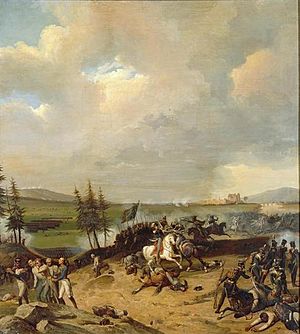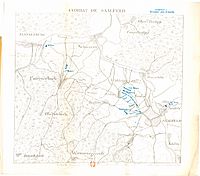Battle of Saalfeld facts for kids
The Battle of Saalfeld happened on October 10, 1806, near the town of Saalfeld in Germany. In this battle, a French army of about 12,800 soldiers, led by Marshal Jean Lannes, fought against a combined Prussian and Saxon force of about 8,300 soldiers. The Prussian-Saxon troops were commanded by Prince Louis Ferdinand.
This battle was an important early clash in the War of the Fourth Coalition, which was a big conflict between France and several European powers. The French won this battle, which helped them gain an advantage in the war.
Quick facts for kids Battle of Saalfeld |
|||||||
|---|---|---|---|---|---|---|---|
| Part of the War of the Fourth Coalition | |||||||
 The death of Louis Ferdinand of Prussia, by Peter Edward Stroehling |
|||||||
|
|||||||
| Belligerents | |||||||
| Commanders and leaders | |||||||
| Strength | |||||||
| 12,000-12,800 men 12 guns |
8,300-9,000 44 guns |
||||||
| Casualties and losses | |||||||
| 172-200 killed or wounded | 900 killed or wounded 1,800 captured 33 guns (15 Prussian, 18 Saxon) |
||||||
Contents
What Led to the Battle?
The Battle of Saalfeld was part of the War of the Fourth Coalition. This war involved France, led by Napoleon, against countries like Prussia, Russia, and Great Britain.
French Army on the Move
Napoleon planned for his large army, called the Grande Armée, to march through the Thuringian Forest. Their goal was to attack the Prussian and Saxon armies. Marshal Jean Lannes led one of the main French groups. His orders were to reach Saalfeld by October 11.
On October 8, Lannes's soldiers began their march. By October 9, they were close to Saalfeld. Early on October 10, Lannes and his troops started moving towards Saalfeld. They knew that Prussian and Saxon forces were waiting for them.
Prussian and Saxon Preparations
Prince Louis Ferdinand was in charge of the Prussian and Saxon advance troops. On October 9, he learned that a large French force was heading for Saalfeld. The Prince knew his main army was planning to cross the Saale River. He decided his troops had to stop the French from crossing the river at Saalfeld. This would prevent the French from getting in the way of his army's movements.
So, Prince Louis gathered his soldiers at Saalfeld. By 9 AM on October 10, his forces were ready for battle. They were lined up in front of Saalfeld, facing the woods where the French were expected to appear.
The Battle Begins
Around 9:45 AM, the first French soldiers arrived near Saalfeld. They were light infantry and two cannons. They quickly took control of the high ground overlooking the town. French skirmishers (soldiers who fight in small, spread-out groups) pushed the Prussian troops out of a nearby village called Garnsdorf.
As the French advanced, Marshal Lannes noticed something important. The right side of the Prussian-Saxon army was open and unprotected. While some French troops fought the Prussians around Saalfeld, Lannes ordered the rest of his soldiers to march north. Their goal was to go around the side of the Prussian and Saxon line.
Prince Louis Ferdinand realized he was facing a much larger French force. Around 11 AM, he received an order to retreat to Rudolstadt. Prince Louis decided to try and pull his troops back from the fight. He sent some soldiers to hold the bridges at Schwarza. He also tried to extend his battle line to protect his right side.
The French kept pushing forward. The Saxon soldiers, who were part of Prince Louis's army, tried to attack. But the French quickly pushed them back. Prince Louis managed to rally his troops and ordered another attack. By midday, his soldiers had captured a place called Crösten.
Turning Point and Prince Louis's Death
Just before 1 PM, Marshal Lannes gave the signal for a full attack. French infantry moved towards the Saxon troops. At the same time, French cavalry (soldiers on horseback) charged forward. Prince Louis decided to send his own cavalry to fight the French cavalry. However, the French had more cavalry, and they quickly surrounded Prince Louis's smaller force.
The Prussian and Saxon cavalry began to break apart and flee. Many soldiers were cut down by the French cavalry. Some even drowned trying to escape across the Saale River. Prince Louis Ferdinand tried to fight his way out of the chaos. During this fight, he was attacked by a French soldier. Prince Louis refused to surrender and was killed in action.
Meanwhile, on the Prussian-Saxon right side, General Bevilaqua tried to bring in more troops. But when he saw the main army falling apart, he ordered a retreat. French cavalry attacked these retreating soldiers, causing them to scatter. General Bevilaqua was captured.
A small Prussian force managed to retreat to Stadt-Ilm. The French cavalry chased the remaining Prussian and Saxon units. However, the French infantry stopped at Schwarza. The battle ended with a clear French victory.
What Happened Next?
Prince Louis's army was completely defeated and scattered. Only a small part of his force remained intact.
Even after this battle and another one at Schleiz, Napoleon still wasn't sure where the main Prussian army was. A few days later, on October 14, the French fought the Prussians and Saxons in two major battles: the Battles of Jena and Auerstedt. These battles were much larger and decided the outcome of the campaign.
Today, a memorial stone marks the spot where Prince Louis Ferdinand died. It honors him for fighting bravely for his country.
More to Explore
- Military flags of the "Müffling", "Kurfürst", and "Prince Clemens" regiments.
Maps of the Battle
- Napoleon Series Map Archives
- Maps of the Battle
Media
- Rugendas, Johan Lorenz, II, "Mort du Prince Louis de Prusse, près de Saalfeld" (1799). Prints, Drawings and Watercolors from the Anne S.K. Brown Military Collection. Brown Digital Repository. Brown University Library.
- Chéreau, J., "Combat de Saalfeld. Mort du Prince Louis de Prusse: 10 8bre 1806 " (1806). Prints, Drawings and Watercolors from the Anne S.K. Brown Military Collection. Brown Digital Repository. Brown University Library
- "Le Prince Louis de Prusse.: Qui commandait l'avant garde du Prince Hohenloe, le 10 octobre 1806, à Saalfeld... " Prints, Drawings and Watercolors from the Anne S.K. Brown Military Collection. Brown Digital Repository. Brown University Library
- "Tod des Prinzen Louis Ferdinand von Preussen" Prints, Drawings and Watercolors from the Anne S.K. Brown Military Collection. Brown Digital Repository. Brown University Library
- Bell, "The Hero Was Mortal", 1807, Royal Collections Trust
- Peter Edward Stroehling (1768-c. 1826), "The Death of Prince Louis Ferdinand of Prussia (1772-1806)", c.1806-16, Royal Collections Trust
- Francois Pigeot, "Death Of Prince Louis Of Prussia At The Battle of Saalfeld", 1850, Getty Images








